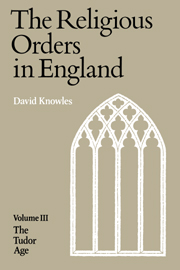Book contents
- Frontmatter
- Contents
- Preface
- List of Abbreviations
- Part One The Tudor Scene
- Part Two The Gathering Storm
- Part Three Suppression and Dissolution
- Chap. XVI Before the Dissolution
- Chap. XVII The end of the Observants
- Chap. XVIII Syon
- Chap. XIX The London Charterhouse and its sister houses
- Chap. XX The economy of the monasteries in 1535
- Chap. XXI Servants, almsgiving and corrodians
- Chap. XXII The visitation of 1535–6
- Chap. XXIII The Act of Suppression and the case for the defence
- Chap. XXIV The dissolution of the lesser houses
- Chap. XXV The Northern Rising
- Chap. XXVI The last phase
- Chap. XXVII The attack on the greater houses
- Chap. XXVIII The suppression of the friars
- Chap. XXIX The cankered hearts
- Chap. XXX The transformation of the buildings
- Chap. XXXI The new cathedrals and colleges
- Chap. XXXII The disposal of the lands
- Chap. XXXIII The treatment of the dispossessed
- Part Four Reaction and Survival
- Appendix I Sir Thomas More's letter ‘to a monk’
- Appendix II Religious houses suppressed by Cardinal Wolsey
- Appendix III The witness of the Carthusians
- Appendix IV Houses with incomes exceeding £1000 in the Valor Ecclesiasticus
- Appendix V The sacrist of Beauvale
- Appendix VI Itinerary of the visitors, 1535–6
- Appendix VII The commissioners for the survey of the Lesser Houses in 1536
- Appendix VIII The conflict of evidence on the monasteries
- Appendix IX The last abbots of Colchester, Reading and Glastonbury
- Appendix X Regulars as bishops
- Bibliography
- Index
Chap. XXVII - The attack on the greater houses
Published online by Cambridge University Press: 08 January 2010
- Frontmatter
- Contents
- Preface
- List of Abbreviations
- Part One The Tudor Scene
- Part Two The Gathering Storm
- Part Three Suppression and Dissolution
- Chap. XVI Before the Dissolution
- Chap. XVII The end of the Observants
- Chap. XVIII Syon
- Chap. XIX The London Charterhouse and its sister houses
- Chap. XX The economy of the monasteries in 1535
- Chap. XXI Servants, almsgiving and corrodians
- Chap. XXII The visitation of 1535–6
- Chap. XXIII The Act of Suppression and the case for the defence
- Chap. XXIV The dissolution of the lesser houses
- Chap. XXV The Northern Rising
- Chap. XXVI The last phase
- Chap. XXVII The attack on the greater houses
- Chap. XXVIII The suppression of the friars
- Chap. XXIX The cankered hearts
- Chap. XXX The transformation of the buildings
- Chap. XXXI The new cathedrals and colleges
- Chap. XXXII The disposal of the lands
- Chap. XXXIII The treatment of the dispossessed
- Part Four Reaction and Survival
- Appendix I Sir Thomas More's letter ‘to a monk’
- Appendix II Religious houses suppressed by Cardinal Wolsey
- Appendix III The witness of the Carthusians
- Appendix IV Houses with incomes exceeding £1000 in the Valor Ecclesiasticus
- Appendix V The sacrist of Beauvale
- Appendix VI Itinerary of the visitors, 1535–6
- Appendix VII The commissioners for the survey of the Lesser Houses in 1536
- Appendix VIII The conflict of evidence on the monasteries
- Appendix IX The last abbots of Colchester, Reading and Glastonbury
- Appendix X Regulars as bishops
- Bibliography
- Index
Summary
The precise moment and occasion of the decision to have done with all the remaining monasteries, great and small, are almost as difficult to discover as are those marking the opening of the first attack. As late as July 1537, the king was elaborately re-founding Chertsey at Bisham and the nunnery of Stixwold in Lincolnshire, in order that they might offer their prayers for himself and his queen, and a whole batch of monasteries was being given formal exemption from the Act of Suppression. Indeed, the arrangements for Bisham were not completed and registered till 18 December, and the trickle of lesser houses officially refounded ‘in perpetuity’ did not dry up till May 1538, when the nunnery of Kirklees received a patent to this effect.
Long before this, however, a new policy was developing. On 11 November 1537, the wealthy priory of Lewes was surrendered to the king. There was a long history behind this, and the prior was in a very vulnerable position, so that pressure could easily be brought to bear on him. Lewes took with it Castleacre, which duly conformed to the surrender on 22 November. A few days later the Premonstratensian abbey of Titchfield in Hampshire followed suit, at the end of a long intrigue.
- Type
- Chapter
- Information
- The Religious Orders in England , pp. 350 - 359Publisher: Cambridge University PressPrint publication year: 1979



